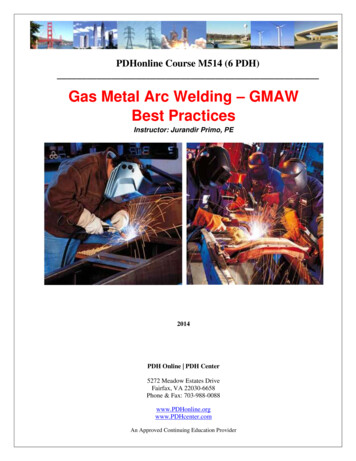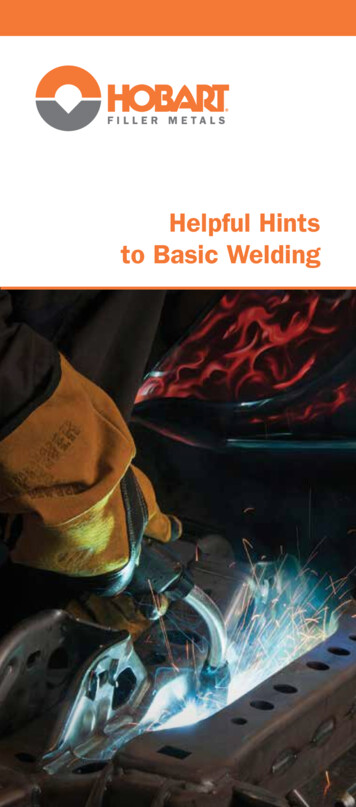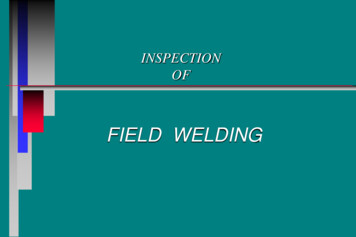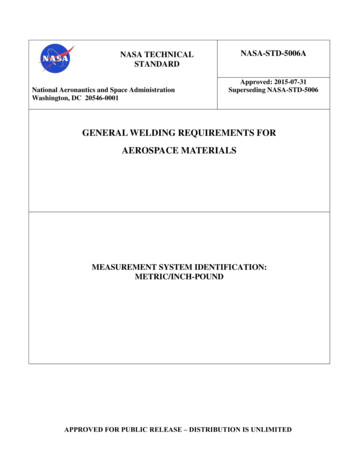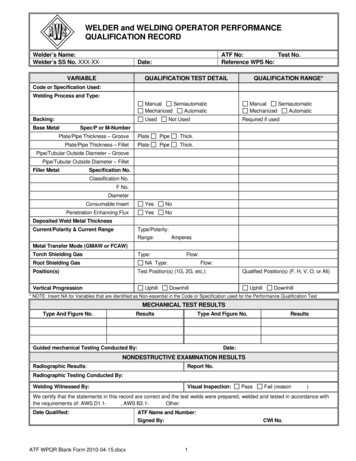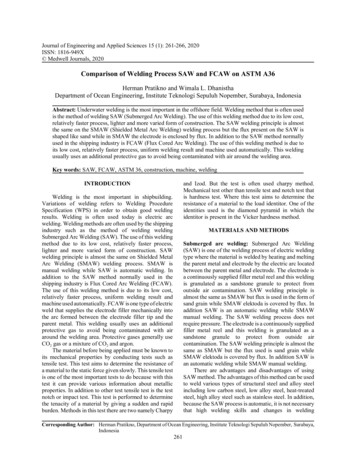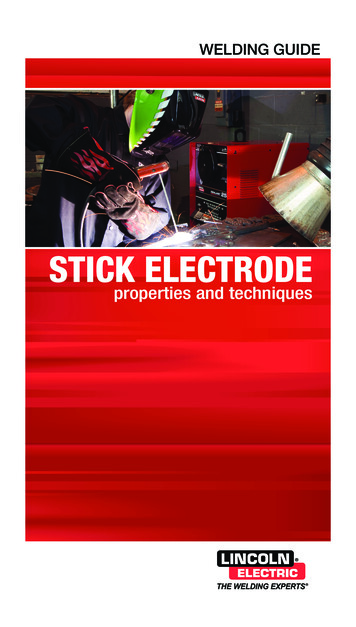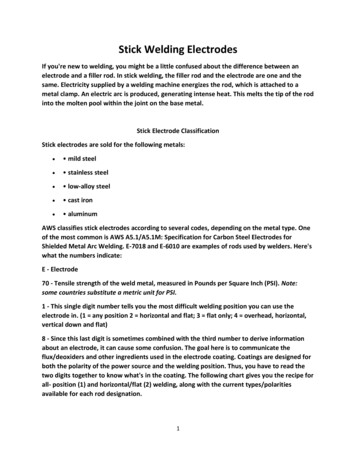
Transcription
Stick Welding ElectrodesIf you're new to welding, you might be a little confused about the difference between anelectrode and a filler rod. In stick welding, the filler rod and the electrode are one and thesame. Electricity supplied by a welding machine energizes the rod, which is attached to ametal clamp. An electric arc is produced, generating intense heat. This melts the tip of the rodinto the molten pool within the joint on the base metal.Stick Electrode ClassificationStick electrodes are sold for the following metals: mild steel stainless steel low-alloy steel cast iron aluminumAWS classifies stick electrodes according to several codes, depending on the metal type. Oneof the most common is AWS A5.1/A5.1M: Specification for Carbon Steel Electrodes forShielded Metal Arc Welding. E-7018 and E-6010 are examples of rods used by welders. Here'swhat the numbers indicate:E - Electrode70 - Tensile strength of the weld metal, measured in Pounds per Square Inch (PSI). Note:some countries substitute a metric unit for PSI.1 - This single digit number tells you the most difficult welding position you can use theelectrode in. (1 any position 2 horizontal and flat; 3 flat only; 4 overhead, horizontal,vertical down and flat)8 - Since this last digit is sometimes combined with the third number to derive informationabout an electrode, it can cause some confusion. The goal here is to communicate theflux/deoxiders and other ingredients used in the electrode coating. Coatings are designed forboth the polarity of the power source and the welding position. Thus, you have to read thetwo digits together to know what's in the coating. The following chart gives you the recipe forall- position (1) and horizontal/flat (2) welding, along with the current types/polaritiesavailable for each rod designation.1
2
Here's a chart that describes six standard electrodes used for welding mild steel:Notice how the ingredients in the coating of the rod affect how the filler metal gets depositedin the weld, as well as the polarity required from the power source.The welding trade also divides stick electrodes into four general groups. These groups arebased on chemical additives in the flux coating which is designed to shield the weld pool. Notonly to prevent oxidation, and porosity, but also to meet the needs of the welder's position:1.2.3.4.Fast Freeze (0,1) - Used for overhead weldingFill Freeze (2,3,4)Fast Fill (21-27) - Limited to flat and horizontal positionLow Hydrogen (18, 28) - Limits porosityThese four categories are not easy for welding students to grasp at first, due perhaps to thelack of creativity in the naming conventions. Yet it helps to become familiar with theterminology, and to remember that not all stick rods work for every situation.3
Another confusing concept concerns polarity in welding. Notice in the two charts shownearlier that there are three choices available under "Current". AC represents the familiaralternating current, which is an acceptable option for all the electrodes listed there, except E6010. The other two options, which pertain to DC (direct current), require a little explanation.DCEP or DC "Electrode Positive" - This is also known as "reverse polarity" and is the choicefor most stick welding. Although electrons inevitably flow through a circuit from its negativeto positive sides, you can effectively reverse the current by switching the connections of yourelectrode holder and the work clamp. (On most industrial sticking welding machinesnowadays, DCEP is either the default setting or accomplished by manipulating the controls tochoose AC, DCEP or DCEN.The objective for using DCEP is to put 70% of the heat (that's generated by the electric arc) atthe tip of the electrode, which can melt it with a vengeance into the joint. The other 30%ends up dispersed around the work piece.DCEN or DC- "Electrode Negative" - This is "straight polarity". Now 70% of the heat getsfocused on the work plates, and only 30% reaches the tip of the electrode. This situation isdesirable when working with thin metal stock or a joint that doesn't require deeppenetration.DCEN is also the choice of polarity for most TIG machines when welding on metals other thanaluminum; TIG welding aluminum prefers AC as its current polarity.There's a lot of confusion about DCEN and DCEP. As a general rule of thumb, TIG likes DCEN,while Stick Welding likes DCEP.Although stick welding is primarily used on carbon steel, you can purchase rods to weld somestainless steels and aluminum. The most common rod for stainless steel is 308, which worksfor base metals that are classified as either 304 or 308 using the AISI standard. Stainlesssteels, incidentally, are classified using three-digit numbers, falling mostly in the 200, 300 and400 range. A common aluminum stick rod is 4043. Aluminum classifications are identified byAISI 4000, 5000 and 6000 series numbers.4
Once a welder has decided on an acceptable electrode, there are two more decisions tomake. What diameter of electrode should be used, and what current range is right for thisdiameter?Consumable sellers usually provide a chart that lists allowable amperage, based on roddiameter. Here's an example:5
Here's a more general range of current settings for a variety of stick welding rods. Notice thatthe table recommends less current when welding in the vertical or overhead position.Choosing the right diameter of the rod depends on the type of joint you're creating and thethickness of the base metal. (The coating around the electrode doesn't count as part of itsdiameter, just the weld metal inside.) Since larger-diameter electrodes produce larger-sizedwelds, you wouldn't want to use a 3/16" rod on metal that's 1/8" thick, and lap joints requirea lot less penetration and weld buildup than a beveled groove joint.Finally, heat is a major concern when welding metals other than carbon steel, so theallowable current range factors heavily into choosing the right rod for stainless steel, otheralloyed metals and aluminum.Care and Storage of ElectrodesLow-hydrogen stick electrodes (e.g. E-7018) require a special storage environment because oftheir coatings (flux). Welders have to keep these rods dry, since moisture in the air (humidity,H2O) contains hydrogen.So long as the welding rods remain sealed inside the box where they were originallypackaged in, no special handling is required. Once the seal is broken, extra care must betaken. In the field, it's common practice to warm batches of rod in an oven at 250 degrees forabout 30 minutes to an hour before use. A welder fetches a handful of warm rods at a time,places them in an electrode pouch, and then goes off to his/her work location. Rods shouldn'tbe heated more than three times in an oven, so it's a good practice to estimate your needswisely on a daily basis.6
Stick Welding Electrodes If you're new to welding, you might be a little confused about the difference between an electrode and a filler rod. In stick welding, the filler rod and the electrode are one and the same. Electricity supplied by a welding machi
